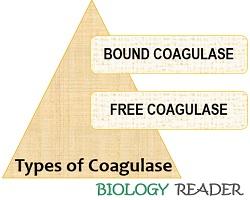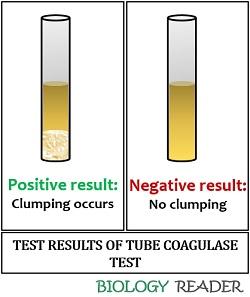The coagulase test is an analytical method that demarcates the staphylococci species into coagulase-positive and coagulase-negative species. Coagulase is an enzyme, which can either bound to the cell surface of bacteria as “Bound coagulase” or reside within the extracellular space as “Free coagulase”.
- Staphylococcus aureus, S. intermedius, S. hyicus are coagulase-positive organisms.
- Staphylococcus epidermis, S. saprophyticus, S. haemolyticus, S. lugdonensis etc., are coagulase-negative organisms.
Slide and tube coagulation method come into use to confer the presence of bound and free coagulase, respectively. Coagulase binds with prothrombin, which results in the proteolysis of fibrinogen into fibrin.
In this context, we will discuss the definition, principle, purpose and the two popular methods of the coagulase test. You would also get to know the meaning of some important terms related to this context.
Content: Coagulase Test
Definition of Coagulase Test
The coagulase test is a biochemical test prevalently employed to differentiate coagulase-positive Staphylococcus aureus from the other Staphylococcus isolates, depending upon the production of the coagulase enzyme. Coagulases break the peptide bonds of fibrinogen to convert them into fibrin clots. The coagulase test procedure involves two methods, namely slide and tube coagulase test.
- The slide coagulase method determines the formation of bound coagulase by the bacterial isolates.
- The tube coagulase method determines the presence of free coagulase.
Overview
Let us discuss some important terms, which we must keep in mind while studying this article.
Coagulase
It refers to a protein enzyme, which associates with thrombin and forms the Staphylothrombin complex. It results in activation of the proteases, which eventually cause proteolysis of fibrinogen (glycoprotein). Thus, the peptide bonds of the fibrinogen break to produce visible strands of fibrin clots.

Coagulase positive organisms produce coagulase enzyme, which causes the conversion of soluble fibrinogen into the solid fibrin clots. In contrast, the coagulase-negative microorganisms cannot convert fibrinogen, as they lack coagulase exoenzyme. Staphylococcus aureus and other coagulase-positive organisms produce two kinds of coagulase exoenzyme, namely bound and free coagulases.

- Bound coagulase: It refers to a “Clumping factor”, whose presence becomes evident after performing the slide coagulase method. Bound coagulase is stable against heat, and it serves as a non-virulent factor. It is a screening method to detect the existence of coagulase in a test organism.
- Free coagulase: It refers to an extracellular coagulase whose presence can be spotted after the tube coagulase method. The free coagulase enzyme is unstable in action to heat, and it acts as a virulent factor. It is a confirmatory method to identify whether a test organism is coagulase-positive or negative.
Thrombin
It refers to the fibrinogenase, which primary function is to form fibrin clots by causing proteolysis of internal fibrinopeptide in the fibrinogen’s plasma protein.
Thrombin works as a clotting enzyme, which comes into action after the splitting of prothrombin by the enzymatic activity of prothrombinase. Then, thrombin acts upon fibrinogen glycoprotein that further splits it into individual strands of fibrin.
Fibrinogen
It is a kind of glycoprotein, which functions as a substrate of thrombin. Fibrinogen is an extracellular protein in the plasma that acts as a “Determiner of platelet aggregation”. It has a molecular weight of 340kDa and an average 150-400 mg/dl concentration in the blood plasma.
Thrombin acts upon the substrate (fibrinogen). It breaks the fibrinopeptide bonds of α and β chains towards the amino terminal. The hepatocytic cells of the liver produce fibrinogen glycoprotein.
Fibrin
It is an insoluble protein, which appears as long fibrous threads. Fibrin is an active protein that participates in blood clotting. It helps in aggregating the platelets to form a spongy mass that stiffens to form a blood clot.
Principle of Coagulase Test
The mechanism of the coagulase test is based on the agglutination reaction. An extracellular coagulase enzyme produced by the coagulase-positive microorganisms breaks the plasma protein (fibrinogen). The coagulase test differentiates organisms into two categories (coagulase-positive and coagulase-negative bacteria).

Coagulase positive microorganisms produce bound and free coagulase enzyme. The bound coagulase combines with the fibrinogen protein of blood plasma and ultimately leads to the precipitation or clumping of fibrinogen.
The free coagulase enzyme combines with the coagulase reacting factor, resulting in fibrinogen clotting to fibrin strands. The coagulase enzyme is also responsible for the pathogenicity of microorganisms.
The cell membrane of some bacteria possess coagulases, which provide resistance against phagocytosis and other host defences. Therefore, the coagulase test also differentiates between the coagulase-positive and potentially virulent organism (Staphylococcus aureus) from the other isolates of Staphylococci.
Purpose
The coagulase test aims the following:
- It is used to detect the production of exocellular coagulase by microorganisms.
- The coagulase test discriminates the two specific groups of bacteria, namely coagulase-positive species (CPS) and coagulase-negative species (CNS), based on coagulase production.
- It also checks the organism’s ability to coagulate the plasma protein fibrinogen into fibrin clots.
Procedure
The coagulase test procedure includes two methods:

Slide Coagulase Method
It detects the cell-bound coagulase, which directly agglutinates the plasma into fibrin clots. It involves the mixing of bacterial suspension with a drop of plasma. The agglutination of plasma indicates a positive coagulase test.
In contrast, the slides with a negative result are confirmed by following the tube coagulase test. Therefore, the slide coagulase test is a screening method that only checks coagulase’s presence or absence.
Protocol
Slide coagulase test involves the following steps:
- Take a clean, grease-free glass slide.
- Pour one drop of undiluted blood plasma towards the centre of the glass slide.
- Sterilize an inoculating loop and carefully take the bacterial suspension.
- After that, mix the bacterial suspension with the drop of blood plasma by moving the sterilized inoculating loop in a clockwise and anticlockwise direction until the formation of milky suspension.
- Allow the glass slide to stand for a few seconds, and then note down the results based on the agglutination reaction.
 Test Results
Test Results
Positive result: The agglutination of the blood plasma occurs within 10 seconds.
Negative result: No agglutination occurs.
Tube Coagulase Method
It detects the presence of free-coagulase (Staphylocoagulase), which indirectly reacts with fibrinogen. Free coagulase reacts with the coagulase reacting factor (thrombin) and converts it into fibrin. It involves incubation of the media containing bacterial suspension added with plasma clotting within 4 hours. It is a confirmatory test that confirms the presence of coagulase.
Protocol
Tube coagulase test involves the following steps:
- Perform serial dilution of the blood plasma in a series of sterile test tubes.
- Pour 1 ml of diluted plasma into the sterile tube.
- Sterilize an inoculating loop under the flame and carefully take the bacterial suspension.
- After that, emulsify the bacterial suspension with plasma until the formation of a milky suspension.
- Allow the test tube to stand for 4 hours in a hot water bath.
- At last, note down the results based on the clot formation by slightly tilting the tube.

Test Results
Positive result: The formation of visible clots develops within 4 hours.
Negative result: No formation of fibrin clots.
It was too informative and conceptional. Best biology website. Keep it up. Thanks!